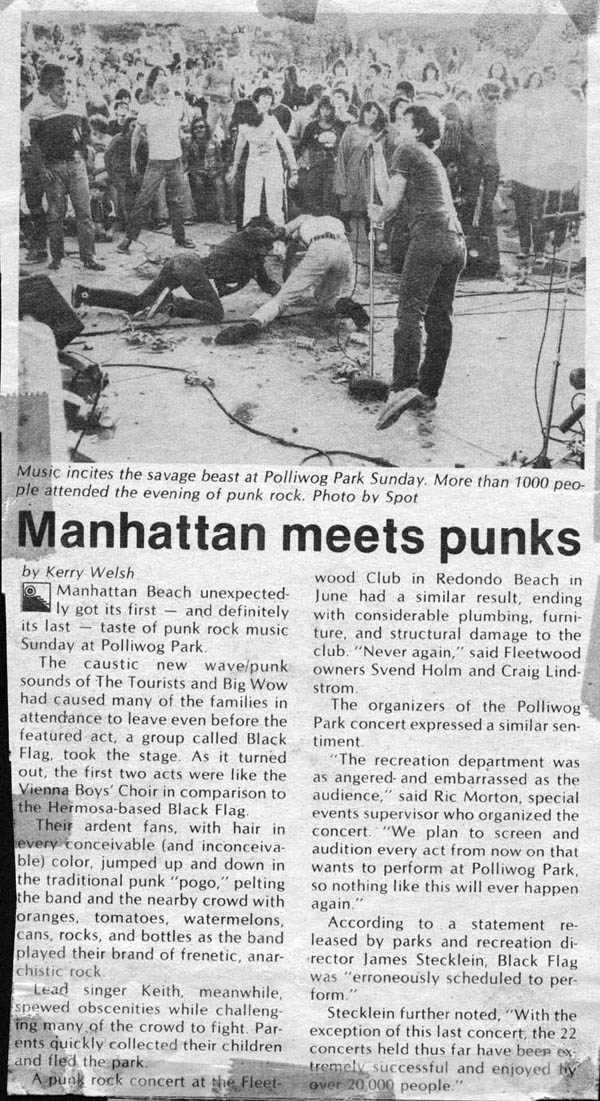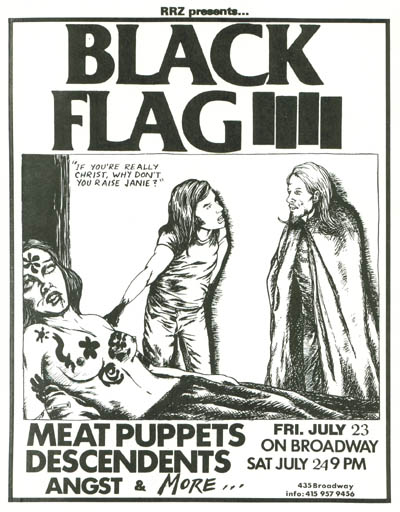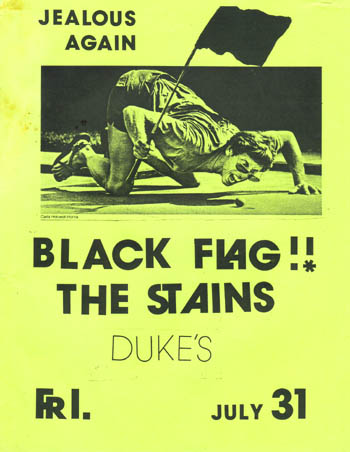
BLACK FLAG
A TWELVE-STEP PROGRAM IN SELF RELIANCE
HOW L.A.'s HARDCORE PIONEERS MADE IT THROUGH THE EARLY YEARS
by Jay Babcock
By midsummer 1981, when the then-unknown, now-notorious Henry Rollins joined Black
Flag as its fourth singer, the South Bay-based punk band had already tasted some
extremely hard-earned success. Despite a set of severe hurdles — from an initial
difficulty in getting local club gigs and a record deal to sensational "punk violence!"
coverage by the news media and constant harassment of both the band and its fans
by police — Black Flag had managed to self-release three EPs, tour North America
several times, and grow from playing to a couple of dozen people at a San Fernando
Valley coffeehouse to headlining shows at the Santa Monica Civic and Olympic
Auditorium.
Black Flag accomplished this by developing a do-it-yourself work and business
ethic which, although common in jazz, rhythm & blues and folk circles for decades,
was almost unique for American rock bands at the time. It was an ethic that was
hugely effective, and one that would prove hugely influential over the next two
decades.
But what's ironic about the band's current historical status as one of American
punk rock's original DIY pioneers — "They may well be the band that made the
biggest difference," says no less an authority than Fugazi's Ian MacKaye — is
that Black Flag's original aspirations had nothing to do with building an alternate
model to the existing music industry.
"The beginning and end of it was always working on the music," says Black Flag
founder, guitarist and chief songwriter Greg Ginn today. "The other stuff was
very much at the periphery."
As they tell it now, Ginn & Co. would have been quite content to let someone else
handle the mundane trivialities of being recording artists and performers: the nuts
and bolts of producing and releasing records, doing publicity and marketing, booking
tours, handling legal matters, lugging equipment, etc. Black Flag would play while
others would work. But the music industry, broadly speaking, wasn't interested in
Black Flag — so Black Flag had to figure out, almost on their own, how to get their
music heard. This is how they did it, in their own words:
1. PRACTICE HARD, ALL THE TIME.
GREG GINN: "For us, it was all about practice, and always playing. A lot of times
we didn't have a place to live, but we always paid for a place to practice hours
every day, through the whole Black Flag history. If we were living in vans, living
in the practice place or staying with people or whatever, we always had a place
to practice."
KEITH MORRIS (first Black Flag vocalist): "We got totally fed up with our original
rhythm section. It got to the point where they were so flaky that we weren't even
rehearsing. We'd started to get our work ethic going, but it didn't hit fifth gear
until we got Robo and Chuck the Duke [Dukowski] in the band. And then it was like
we rehearsed every night, sometimes for six hours. Sometimes I wouldn't be getting
home until, like, 4 in the morning."
GINN: "I thought that if you're gonna call yourself a band and claim to play music,
it's not too much to ask that you practice a couple hours, five nights a week.
But a lot of people thought, 'Well, we'd rather party or hang out or this or that.'
And punk rock, there was a lot of that mentality — 'Why do you need to practice
so much?' It was supposed to be 'Everything's zero, and life's not worth anything,
so why would you bother practicing?' I' m not saying that my attitude is right.
Other bands were different. Like the Germs — they didn't practice, and I loved
to go see them play. I wouldn't have tried to change them! I was just, 'Okay,
that's them. We're not the Germs. We're doing something different.'"
2. HAVE EXPERIENCE RUNNING A SMALL BUSINESS.
Ginn, who graduated from UCLA with an economics degree, started his first business
— SST Electronics — when he was in junior high school, and continued to run it
through college and into his 20s. SST provided friends with work — Morris, Dukowski
and Mike Watt (among others) all made antenna tuners or other ham-radio accessories
at some point — and generated the seed money Ginn used to fund Black Flag's early
activities.
MORRIS: "Greg was basically our financier — he was our industrial capitalist."
While he was at UC Santa Barbara, Chuck Dukowski ran a production company that put
on shows and movies. He'd also "toured" the U.S. in a van twice, playing rock gigs
with a high school friend in a band that eventually became Würm.
DUKOWSKI (bass): "We had a single 12-inch speaker, we'd both plug into it, and
we'd go and jam everywhere. After college, we rented a bunch of different storefronts
and commercial spaces that we'd live in and practice in, and try to get the ball
rolling with our band. Eventually, we ended up in a deserted bathhouse and
restaurant in Hermosa Beach. We bought and sold musical equipment to make money.
Würm couldn't get gigs, so we played to 20 to 30 people a night, pretty much seven
days a week, at our pad. We had it all organized — how to stay underground and
avoid getting into trouble. We even had a secret knock."
After Würm fell apart, Dukowski joined Black Flag (then called Panic) and took
a day job as a foreman at a local pool-table manufacturing company.
DUKOWSKI: "[In late '79] I was just sitting around at this job, being the foreman,
and I smelled the solvents floating in the air, and I went, 'This isn't good for
me. I want to go into music, that's what I've been wanting to do all along.' And
I'd seen that this guy built this pool-table place from nothing, and I had some
experience in entertainment, and I had experience with touring — not as a band,
but traveling and being self-sustaining on the road for months at a time. So I
quit, and my primary focus became SST. Greg had invited me to be a partner at the
label. I walked in, I said, 'Okay, I got time and energy, I wanna make it work.
We got a little bit of time to set it up, because soon enough my savings will
run out.'"
3. DO YOUR OWN PUBLICITY.
(a) GRAFFITI
One of Greg Ginn's younger brothers was Raymond Pettibon, an artist who specialized
in chilly one-panel comic-book-style drawings with unsettling captions. Pettibon
came up with the name Black Flag, as well as the band's logo and its marvelously
simple emblem: an unfurled flag broken in three so that it appeared as four solid
vertical black bars. The "four bars" was perfect for graffiti.
MORRIS: "Aw, we had graffiti everywhere — freeway overhangs, underpasses. We were
probably the original L.A. taggers."
ROBO (drums): "Greg's girlfriend Medea used to go to Hollywood with a spray can,
and every wall that she saw, she put up the four bars. The police were like,
'Who the fuck is doing all this four bars everywhere?'"
GINN: "In the South Bay, the band was known for its graffiti. It was so uncommon
that when you did it, everybody saw it. That was the one outlet that we had to
publicize the group. Which I think is totally justifiable in light of the cartel
in music that the big record labels had going — and still have, to a certain extent.
If people don't have a voice at all, if the government is supposed to support
free enterprise but they're supporting these really close-knit cartels, then the
people need to make some kind of noise to start breaking that stuff up."

(b) FLIERS
Pettibon's artwork was also featured on almost all of Black Flag's fliers
advertising upcoming gigs. The posters for a series of late-1980 shows around
L.A. that had been nicknamed "creepy crawls" (after a term used by the Manson
family for breaking into people's houses and rearranging their furniture) are
particularly intense. One features a blond girl warning an X-carved-between-the-eyebrows
Charles Manson ("You better be good, Charlie. It wasn't easy getting in here you know").
The fliers' content — and their ubiquity on telephone poles and street walls —
contributed to the band's already edgy, menacing mystique.
MORRIS: "We would go out on our flier-pasting missions in Robo's little white Ford
Cortina. We'd have the bucket with the paste, we'd have a few hundred fliers, and
after all the fliers were posted, like three or four hours, we'd go home and go
to sleep."
DUKOWSKI: "The minimum that went out was 500 for a show. I made a wheat-paste/white-glue
mix so that it would stay up longer. Nobody did that. When I was producing shows in
college, I realized you need to plaster this shit — you need to put 30 of them here,
and they need to be put up so they' re there for a while. The Dogs and other people
had been doing it, but they could have been more aggressive — they weren't putting
them up on poles. That helped us get over, for sure . . . For one of those early
shows, we put fliers somewhere, and Greg had to go to court for it. And they fined
him or something. Our response to that was to go right from the courthouse to the
Redondo Beach police station and graffiti the station wall in broad daylight."
4. GET LOCAL GIGS.
Unable to get a show anywhere, the band decided to book a late-January '79 afternoon
at a Moose Lodge in Redondo Beach and put on a show itself. The event drew less than
100 people, but included two of the band's future singers — and an impressed Rodney
Bingenheimer, who began playing the band's first single immediately after.
GINN: "There was an underground of rock bands in L.A. in '74, '75 — before punk rock.
The Alleycats, the Last, the Dogs, the New Order. Those bands were playing outside
of the put-on-a-stage-show, wear-costumes, showcase-for-the-label thing. They'd
rent halls, do fliers. They would just keep plugging away, to very limited success.
I really picked up on the kind of work ethic those bands had."
DUKOWSKI: "Greg organized most of the bookings at first. We played a lot of local
clubs, but it was more catch-as-catch-can kind of stuff. One advantage Black Flag
had was there was a place where we could be reached, 'cause he had a business
phone for SST Electronics."
Black Flag began making a name for itself in the Hollywood scene by playing a series
of gigs at local clubs that summer. Then, somehow, Ginn got Black Flag on the bill
for a free Sunday-afternoon concert at Polliwog Park in Manhattan Beach. The band's
set was accompanied by a barrage of lunch food thrown at the band — and its few fans
— by the disapproving audience of picnicking families. Black Flag's first gigs at
other unconventional venues were also usually their last.
GINN: "I got real good at talking to promoters or hall owners. They'd ask, 'What
kind of music do you play?' I'd say, 'Oh, it's a rock group and a little bit of
jazz in there.' That's a trick — the 'jazz' word is always useful when you're
stopped by police or authorities. 'What kind of music do you guys play?' If you
answer 'rock,' they ask, 'What kind of rock?' But if you throw that little 'jazz'
thing in there . . ."
DUKOWSKI: "Once I had the time and energy to put into booking the band's shows,
we started putting together packages to attract audiences from different parts
of the city. We'd say, 'Okay, we're gonna have a group from here, a group from
there, bring it all together and promote the hell out of it. We get these people's
audiences plus a few new people each time.' And it worked."
GINN: "We didn't turn down any free gigs, because those were the best. It'd cost
us money, because we'd rent PAs, but I always liked free gigs because anybody
can wander in. You could get different people at random, not pre-selected groups
of people, and maybe they would get something out of it. That's how I got into
music, through free stuff . . ."

5. TOUR.
After playing dates up and down the West Coast several times, in December 1980
the band embarked on its first national tour, booking shows with often unknown
promoters at often questionable venues on hearsay information passed to them
by other touring punk bands like San Francisco's Dead Kennedys, Vancouver's
D.O.A. and Texas' Big Boys. Black Flag toured the U.S. three times in nine months
spanning '80-'81.
DUKOWSKI: "We needed to work, to keep the ball rolling. Especially if you're only
making 50 bucks, 100 bucks, something like that, every time you do it. We needed
to play every night. And the only way to play a show every night was to tour."
GINN: "We tried to book a show every day, and then cancellations would be days off.
And as we went, we could fill it in more. There's no way we could have done the
same thing [using normal music-business procedures and personnel], because who's
gonna book tours so they can take their 15-percent share for a show where we made
$50? Who's gonna go along with it and do all the work and say, 'We play any live
gig, we put parties ahead of paying things'? That's what we did for our whole career.
You have to take yourself outside of the regular business, because no manager or
label is gonna have the foresight to do all of that stuff to create something
bigger, because they can't see their interest beyond the short term."
ROBO: "We set up our own instruments, we only had one roadie, which was a teenage
street kid nicknamed Mugger. I'd carry my drums in all by myself, Greg carried,
and Chuck carried in his cabinets. We all did it ourselves. No bullshit. We only
wanted a bright white light on us, so we could see each other and people could
see us. None of this bullshit of fog and smoke and dimmed lights. If there's a
drum riser on the stage, get it off! We want a carpet and a white light. We don't
need nothing else!"
6. WATCH YOUR DIET.
DUKOWSKI: "Ron Reyes [the band's second singer] had next to no money and was living
on potatoes. Which is a pretty good choice of food to live on. But on the other
hand, he was living too hard — he was drinking a lot — and tried to be a vegetarian
too. Not having enough money to eat right, that's a good way to get malnourished.
He freaked out."
ROBO: "I sweat like a pig from the way I play. I really put out. So, playing so
much, I lost a lot of weight. I'd been a vegetarian for like seven or eight years.
I said, 'Man, I'm gonna either drop dead or get sick.' So I started eating meat
again."
CONTINUED ON PAGE TWO



CONTACT: Break My Face




![]()
![]()
![]()